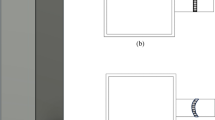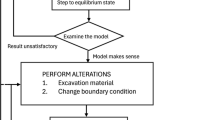Abstract
Burden is one of the major influencing blast design parameters which should be optimised for the extraction of narrow vein ore bodies. Numerical simulation-based approach has been used for the optimisation of burden in this paper. Different models were prepared under varying parametric conditions including width of the vein, blasthole diameter and burden. The RHT concrete constitutive model was used for the analysis of damage contour. The volume of the excavated rock along the free face (EV) was quantified from the model output in all the scenario. The study showed that EV initially increases with the increase in burden for a particular width of vein. Furthermore, EV starts decreasing after a point termed as pivot point. The value of burden at this pivot point was considered as optimal in this study. The best fit curve between EV and burden for three blasthole diameter and seven different width of vein were plotted. In all instances, the outputs of the model followed the second-degree polynomial equation. The study also suggests that the optimum burden reduces with the increase in the width of the vein. It has also been found that the optimum burden follows power trend with the increase in width of the ore body irrespective of blasthole diameter. Based on the optimum burden obtained from the output of simulation along with different blasthole diameter and width of the ore body, an empirical relationship has been established. The developed empirical relationship has a good agreement with the experimental trial data.
Highlights
-
Numerical simulation technique has been used in this paper for the optimisation of burden while extraction of narrow vein stopes.
-
The study suggest that the relation of volume of the excavated rock along the free face and burden is second-degree polynomial in nature.
-
It has been found that the optimum burden for narrow vein is higher as compared to wider width ore body.
-
Study also suggest that optimum burden follows power trend with the increase in width of ore body.
-
The influence of width of the ore body in the selection of burden vanishes after certain width of ore body as per the observation of model output.










Similar content being viewed by others
Data Availability
The datasets used and analyzed during the current study are available from the corresponding author on reasonable request.
References
Abdel-Kader M (2019) Modified settings of concrete parameters in RHT model for predicting the response of concrete panels to impact. Int J Impact Eng 132:103312
Allsman PL (1960) Analysis of explosive action in breaking rock. Trans Aust Inst Min Metall 217:475
An L, Suorineni FT, Xu S, Li YH, Wang ZC (2018) A feasibility study on confinement effect on blasting performance in narrow vein mining through numerical modelling. Int J Rock Mech Min Sci 112:84–94
Anderson O (1952) Blast hole burden design-introducing a new formula. Aust Inst Min Metall 166–167:115–130
Ash RL (1963) The mechanics of rock breakage (part 3)-characteristics of explosives. Pit Quarry 56:126–131
Bhagat NK, Mishra AK, Singh MM, Rana A, Singh PK (2020) Innovative directional controlled blasting technique for excavation of unstable slopes along a busy transportation route: a case study of konkan railway in India. Min Metall Explor 37(3):833–850
Borrvall T, Riedel W (2011) The RHT concrete model in LS-DYNA. In: Proceedings of The 8th European LS-DYNA user conference
Brewis T (1995) Narrow vein mining 1- steep veins. Min Mag 173(3):10
Clark LM (1998) Minimizing dilution in open stope mining with a focus on stope design and narrow vein longhole blasting (Doctoral dissertation, University of British Columbia)
Dominy SC, Platten IM (2008) Continuity risk in narrow reef gold deposits: implications for evaluation and exploitation. In:Proc Conf on ‘Narrow vein mining, 31–49
Dominy SC, Sangster CJS, Camm GS, Phelps RFG (1987) Narrow-vein stoping practice: a United Kingdom perspective. Notes 150(1986):A122–A136
Duranović M, Đokić N, Lapčević V, Torbica S, Petrović M, Savić L (2018) Optimization of ring blasting in sublevel stoping gold mine. Podzemni Radovi 33:61–68
Esen S, Onederra I, Bilgin HA (2003) Modelling the size of the crushed zone around a blasthole. Int J Rock Mech Min Sci 40(4):485–495
Field JE, Ladegaard-Pedersen A (1971) The importance of the reflected stress wave in rock blasting. Int J Rock Mech Min Sci Geomech Abstr 8(3):213–226
Finkel M, Olsson M, Thorshag H, Wernstron J, Johansson G (2001). Narrow ore mining in Zinkgruvan, Sweden. Underground mining methods–engineering fundamentals and international case studies, 221–227
Fraenkel KH (1954) Handbook in rock blasting technique. Part-1, Esselte AB, Stockholm, 378
Gao W, Zhang J, Li C, Cheng L, Liu P (2023) Study on muck pile shape of open-pit bench blasting based on PFC. Shock Vib 2023:1–10. https://doi.org/10.1155/2023/2859668
Germain P, Hadjigeorgiou J, Lessard JF (1996) On the relationshp between stability prediction and observed stope overbreak. In: Rock mechanics tools and techniques, pp 277–283
Hansen DW (1967) Drilling and blasting techniques for morrow point power plant. In The 9th US symposium on rock mechanics (USRMS). OnePetro
Hansson H, Skoglund P (2002) Simulation of concrete penetration in 2D and 3D with the RHT material model. Swedish defense research agency
Henning JG (2007) Evaluation of long-hole mine design influences on unplanned ore dilution
Henning JG, Mitri HS (2007) Numerical modelling of ore dilution in blasthole stoping. Int J Rock Mech Min Sci 44(5):692–703
Himanshu VK, Roy MP, Mishra AK, Paswan RK, Panda D, Singh PK (2018) Multivariate statistical analysis approach for prediction of blast-induced ground vibration. Arab J Geosci 11(16):1–11
Himanshu VK, Mishra AK, Roy MP, Vishwakarma AK, Singh PK (2021) Numerical simulation based approach for assessment of blast induced deformation pattern in slot raise excavation. Int J Rock Mech Min Sci 144:104816
Himanshu VK, Mishra AK, Vishwakarma AK, Roy MP, Singh PK (2022a) Explicit dynamics based numerical simulation approach for assessment of impact of relief hole on blast induced deformation pattern in an underground face blast. Geomechan Geophys Geo-Energy Geo-Resour 8:1–18
Himanshu VK, Mishra AK, Vishwakarma AK, Roy MP, Singh PK (2022b) Prediction of blast-induced ground vibration using principal component analysis-based classification and logarithmic regression technique. Min Metall Explor 39(5):2065–2074
Himanshu VK, Mishra AK, Roy MP, Singh PK (2023a) Overview of underground metalliferous mining. Blasting technology for underground hard rock mining. Springer Nature Singapore, Singapore, pp 9–24
Himanshu VK, Mishra AK, Roy MP, Singh PK (2023b) Underground ring blasting. Blasting technology for underground hard rock mining. Springer Nature Singapore, Singapore, pp 75–91
Himanshu VK, Mishra AK, Roy MP, Singh PK (2023c) Rock-explosive interaction during underground blasting. Blasting technology for underground hard rock mining. Springer Nature Singapore, Singapore, pp 25–48
Hino K (1959) Theory and practice of blasting. Nippon Kayaku Company
Konya CJ, Walter EJ (1991). Rock blasting and overbreak control (No. FHWA-HI-92-001; NHI-13211). United States. Federal Highway Administration
Konya, C. J. (1972). The use of shaped explosive charges to investigate permeability, penetration, and fracture formation in coal, dolomite and plexiglas
Langefors U, Kihlström B (1963) The modern technique of rock blasting, vol 405. Wiley, New York
Li X, Liu K, Yang J, Song R (2022) Numerical study on blast-induced fragmentation in deep rock mass. Int J Impact Eng 170:104367
Modi SK, Murthy VMSR (2022) Assessment of blasting impacts in underwater concrete berth demolition and development of a hybrid controlled blasting (HCB) technique–a case study. Structures 40:420–433
Murlidhar BR, Kumar D, JahedArmaghani D, Mohamad ET, Roy B, Pham BT (2020) A novel intelligent ELM-BBO technique for predicting distance of mine blasting-induced flyrock. Nat Resour Res 29(6):4103–4120
Myers T, Lundquist R, Konya C (1990) Proc 16th ISEE Annual Conf. Orlando, FL, USA, ISEE, pp 43–52
Nicholas DE (1981). Method selection-a numerical approach. Design and operation of caving and sublevel stoping mines, pp 39–53
Onederra IA, Furtney JK, Sellers E, Iverson S (2013) Modelling blast induced damage from a fully coupled explosive charge. Int J Rock Mech Min Sci 58:73–84
Pakalnis RC, Poulin R, Hadjigeorgiou J (1996) Quantifying the cost of dilution in underground mines. Int J Rock Mech Min Sci Geomech Abstr 5(33):233A
Pearse GE (1955) Rock blasting—some aspects on the theory and practice. Min Quarry Eng 21:25–30
Potvin Y (1988) Empirical open stope design in Canada (Doctoral dissertation, University of British Columbia)
Procházka PP (2004) Application of discrete element methods to fracture mechanics of rock bursts. Eng Fract Mech 71(4–6):601–618
Riedel W, Thoma K, Hiermaier S, Schmolinske E (1999) Penetration of reinforced concrete by BETA-B-500 numerical analysis using a new macroscopic concrete model for hydrocodes. In Proceedings of the 9th international symposium on the effects of munitions with structures (Vol. 315). Berlin-Strausberg Germany
Roy PP (2005) Rock blasting: effects and operations. Taylor & Francis, Netherlands
Roy MP, Himanshu VK, Kaushik AP, Singh PK (2022) Influence of ring blasting pattern on the safety of nearby underground structures. Sādhanā 47(4):192
Rustan PA (1990) Rock fragmentation by blasting (Fragblast 1990)’, Brisbane, Australia, August 1990, AusIMM: 303–310
Scoble MJ, Lizotte YC, Paventi M, Mohanty BB (1997) Measurement of blast damage. Min Eng 49(6):103–108
Stewart P, Trueman R, Lyman G (2007) Development of benchmark stoping widths for longhole narrow-vein stoping. Min Technol 116(4):167–175
Stewart PC, Trueman R (2008) Strategies for minimising and predicting dilution in narrow-vein mines–NVD Method. Aust Inst Min Metall 153–164
Sun Q, Williams B, Loeffler C, Martin B, Heard W, Frew D, Nie X (2021) Comparative study of strength-based damage evolution in ultra-high-performance concrete (UHPC) and conventional concrete (CC) under dynamic loading. Int J Impact Eng 155:103893
Towsey CAJ (2008) Narrow vein mining at charters towers, Queensland by longhole open stoping. Proc Narrow Vein Min Conf 2008:9–12
Vallejos JA, Díaz L (2020) A new criterion for numerical modelling of hangingwall overbreak in open stopes. Rock Mech Rock Eng 53(10):4559–4581
Vishwakarma AK, Himanshu VK, Kumar S, Roy MP (2020). Overbreak control in development face blasting of underground metal mine—a case study. In Proceedings of national conference on advances in mining (AIM-2020), 473–482
Vishwakarma AK, Murthy VMSR, Himanshu VK, Prakash A, Mehrotra S (2023). Investigations on the influence of applied thrust on rock penetration rate by a raise boring machine using numerical simulation and experimental trials. Min Metall Explor 40:1187–1197. https://doi.org/10.1007/s42461-023-00779-1
Wimmer M, Nordqvist AA, Ouchterlony F, Selldén H, Lenz G (2012) 3D mapping of sublevel caving (SLC) blast rings and ore flow disturbances in the LKAB Kiruna mine. In: International conference exhibition on mass mining: 10/06/2012-14/06/2012. Canadian Institute of Mining, Metallurgy and Petroeum
Wu Y, Crawford JE, Lan S, Magallanes JM (2014). Validation studies for concrete constitutive models with blast test data. In Proc., 13th Int. LS-DYNA® Users Conf., LSTC, Livermore, CA
Yan P, Zhou W, Lu W, Chen M, Zhou C (2016) Simulation of bench blasting considering fragmentation size distribution. Int J Impact Eng 90:132–145
Yu Z, Shi XZ, Zhang ZX, Gou YG, Miao XH, Kalipi I (2022) Numerical investigation of blast-induced rock movement characteristics in open-pit bench blasting using bonded-particle method. Rock Mech Rock Eng 55(6):3599–3619
Zhang ZX, Sanchidrián JA, Ouchterlony F, Luukkanen S (2023) Reduction of fragment size from mining to mineral processing: a review. Rock Mech Rock Eng 56:747–778
Acknowledgements
The authors are highly thankful to the mine management of the Zawar group of mine, HZL for providing permission to carry out the study. The cooperation and support provided for completing this paper and study by CIMFR and IIT Kharagpur is also highly acknowledged. This work is a part of the Ph.D. work of the corresponding author.
Author information
Authors and Affiliations
Corresponding author
Additional information
Publisher's Note
Springer Nature remains neutral with regard to jurisdictional claims in published maps and institutional affiliations.
Rights and permissions
Springer Nature or its licensor (e.g. a society or other partner) holds exclusive rights to this article under a publishing agreement with the author(s) or other rightsholder(s); author self-archiving of the accepted manuscript version of this article is solely governed by the terms of such publishing agreement and applicable law.
About this article
Cite this article
Vishwakarma, A.K., Himanshu, V.K. & Dey, K. Evaluation of Optimum Burden for the Excavation of Narrow Vein Ore Deposits Using Numerical Simulation. Rock Mech Rock Eng 57, 945–960 (2024). https://doi.org/10.1007/s00603-023-03596-6
Received:
Accepted:
Published:
Issue Date:
DOI: https://doi.org/10.1007/s00603-023-03596-6




